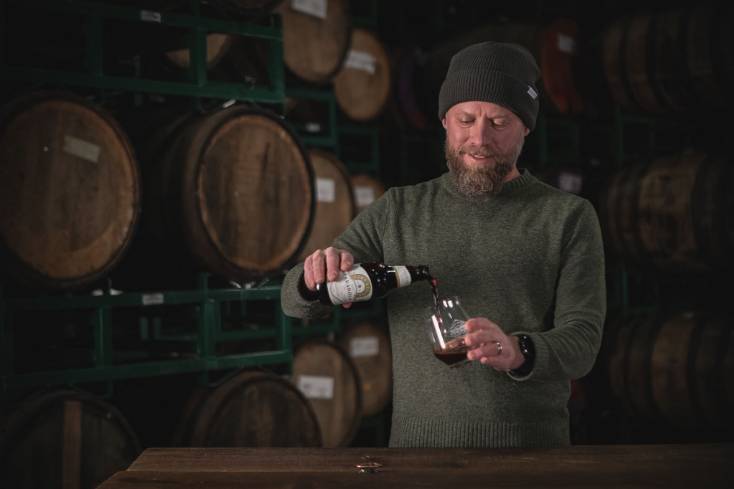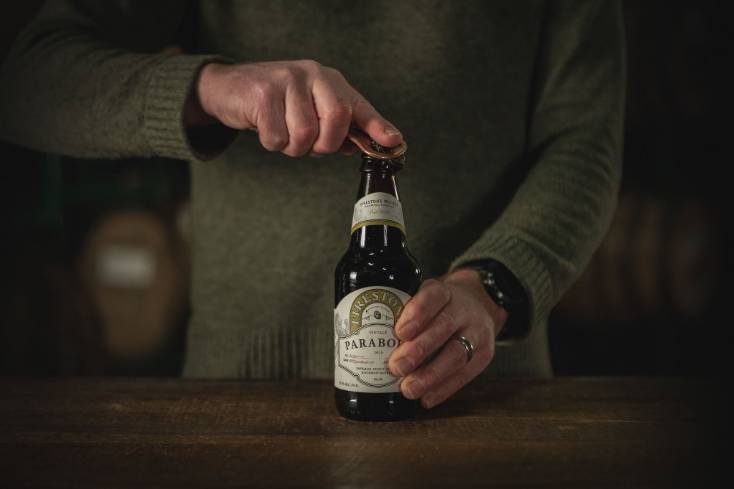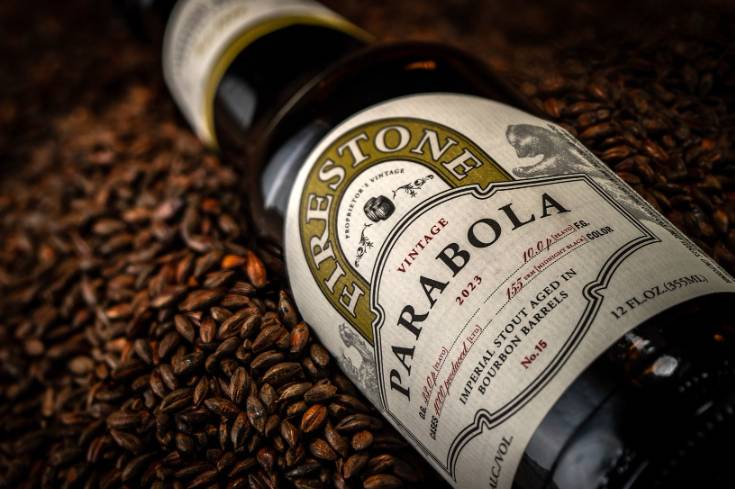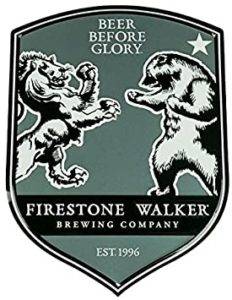
(Matt Brynildson: Courtesy Firestone Walker)
Few brewers command the kind the kind of respect that Firestone Walker’s Matt Brynildson does.
When Firestone Walker co-founders Adam Firestone and David Walker moved their brewing operations to Paso Robles in 2001, they also landed “the perfect brewmaster at the perfect time and Brynildson’s been guiding the brewery’s brewing directions ever since.
American Craft Beer recently had the opportunity to sit down with Matt, one of craft beer’s leading brewmasters, to get his take on Firestone Walker’s 2023 Parabola, and the art of making a serious barrel-aged stout.
First released in 2010, Parabola has become its own phenomenon, a barrel-aged Imperial Stout that debuts every spring and still owns a perfect 100-point rating on Beer Advocate.
ACB: Any serious barrel-aged stout starts with what is being aged. Has the base Parabola stout recipe remained the same over the years, or like the barrels you use has that too evolved?
The original Parabola recipe was put together back in 2005 and it certainly has evolved since that time as we became more familiar with the available ingredients and the barrel aging process. The most notable adjustment is a significant increase in original gravity, which has increased the girth of the beer over time.
There have been a number of process changes as well, optimizing the way the beer flows through the brewhouse and cellar, focusing on quality. We have made a lot of great connections within the distilling community and barrel broker network, which has improved the barrel selection over time as well.
ACB: Unlike Goose Island’s annual Bourbon County Stout variations which are sometimes influenced by additives like coffee or fruit, Parabola is all about the casks used in aging as well as its blending. Have we got that right?
In the earlier years we focused on non-adjuncted barrel aged beers and more on unique barrels and the blending side of the process. More recently we have introduced a number of adjuncted variants on Parabola, such as Parabolita. For example, we’ve used coffee from local roasters, cocoa nibs, coconut and a host of other adjuncts over the past year.
We don’t typically push Parabola variants to the pastry stout extremes, but try to work with whole natural ingredients and find a balance that doesn’t take over the beer. That said, the mainstay Parabola is released every year in its original, pure, barrel aged form.

(Courtesy Firestone Walker)
ACB: Each year’s Parabola reflects the differing nuances of the types of casks used in the aging process. Are we to assume that the casks used are always different?
We take a pretty open approach to deciding on what barrels we age Parabola in each year. Honestly, it is usually the very best barrels we can find at that time. That said, it is almost always bourbon and more times than not those casks come from Heaven Hill.
We have created a barrel select release program that we named Paraboloid, which is a small release of beer aged in super rare and unique barrels. It’s relatively new but it allows us to seek out small batch producers or rare releases and share them with our fans without blending these special barrels away into the larger Parabola blends. The most recent release was aged in ultra-rare 20-year-old Elijah Craig barrels.
ACB: This might seem like a stupid question, but we have to ask. Once you’ve decided upon on the barrels you’ll be using for each year’s Parabola, do you taste test them throughout the year to make sure you’re happy with where things are going?
We do sample every barrel that we intend to blend and ensure quality while getting an idea of where the batch is going. Sampling and tasting are things that we tend to do on a limited periodic basis so that we are not disturbing the beer, allowing additional oxidation to set in or exposing it too much.
“Pulling nails” is not something we do. That said, we get plenty of opportunities to taste along the way and certainly do a lot of tasting at the point of blending. It’s fun to see how the beer progresses and we have learned that Parabola is pretty interesting after some extended 18 month+ aging times at our cooler cellar temperature of 10C.
ACB: We’ve always considered a beer’s name to be an intrinsic part of its character. Why Parabola?
(See below)

(Courtesy Firestone Walker)
ACB: What can you tell us about its origins of Parabola?
In terms of the name, let’s just say I was seeing a lot of Tool shows back in and around 2005. The recipe is simply the evolution of our interpretation of Imperial Stout brewed specifically for barrels and not as a stainless-only beer. We take a bit of an old school approach but continue to improve and adjust the recipe as we see fit.
ACB: You’ve been releasing Parabola for well over a decade. Do you have any past favorites?
I get asked that a lot and I really don’t think a lot about past batches. It’s more about looking forward toward the next release and trying to improve upon what we think is a pretty solid beer
If I had to recall a favorite Parabola batch from memory, I might pick the Double Barrel aged batch that we released in 2021 and that took the first place gold award at FoBAB (Festival of Barrel Aged Beers) in Chicago. That’s a pretty special event and it feels pretty good to have our barrel aging peers back in Chicago recognize a beer that we were pretty proud of.
ACB: Does Firestone Walker have a saved collection of every Parabola released since 2010 stashed away somewhere? It would be so cool to taste how they’ve evolved after different years of cellaring.
I’m pretty sure that we have a lot of the batches in the library but we might be short a few of the earlier years. We are trying to make a conscious effort to maintain a better library these days.
We do taste 10-year-old beers from our Vintage Reserve program on a regular basis and they hold up well at refrigerated cellar temperatures. We also open up vertical tasting opportunities for our Brewmaster’s Collective club members.
 ACB: Seems like fewer craft breweries are making barrel-aged stouts nowadays. Why do you think that is and to what do you credit Parabola’s staying power?
ACB: Seems like fewer craft breweries are making barrel-aged stouts nowadays. Why do you think that is and to what do you credit Parabola’s staying power?
There may not be as many breweries producing these beers but I certainly think there are a lot of great brewers still making them.
Goose Island, Side Project, Private Press, Highland Park, Ten Fifty, Revolution, New Holland, Sierra Nevada, Bells, Omnipollo… actually I could go on and on. If you look for them, you will find them.
There might not be as many new brewers committing to large barrel aging programs, but there are a lot of established Imperial Stout producers who are still elevating their game.
###
 American Craft Beer The Best Craft Beer, Breweries, Bars, Brewpubs, Beer Stores, And Restaurants Serving Serious Beer.
American Craft Beer The Best Craft Beer, Breweries, Bars, Brewpubs, Beer Stores, And Restaurants Serving Serious Beer.
